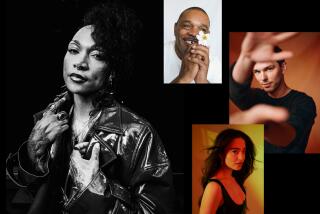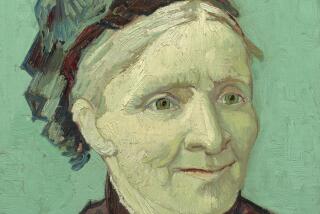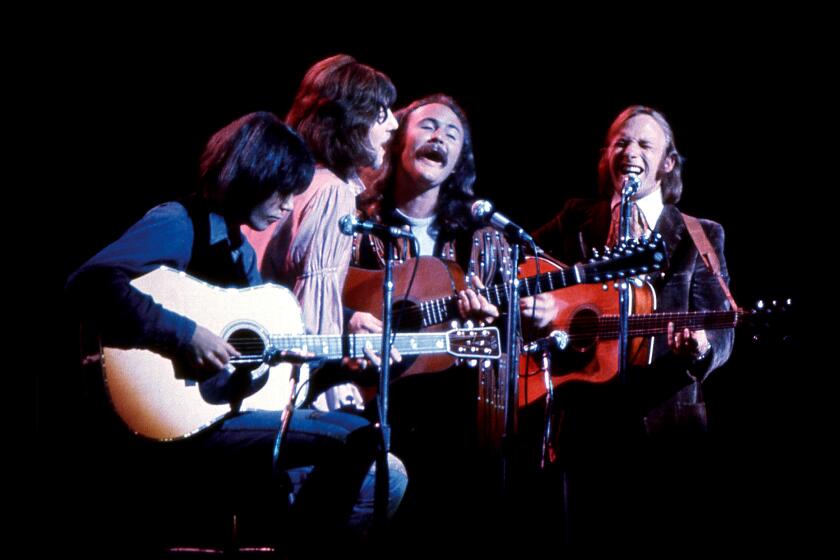It’s her show
- Share via
Santa Barbara — Santa Barbara
The issue of artistic influence -- of whether (and how) one artist’s work and methods may or may not have affected those of another -- is never an easy question to answer. To see why, just open Webster’s, where influence is first defined in flatly supernatural terms: “the flowing of an ethereal fluid or power from the stars, thought to affect people’s character and actions.”
At the Santa Barbara Museum of Art, a deeply engrossing exhibition of photographs from the ‘teens and 1920s parses the question in regard to two artists -- one of them securely ranked among the greatest photographers of the 20th century, the other barely known beyond the ranks of specialists. “Margrethe Mather & Edward Weston: A Passionate Collaboration” does chronicle the cooperative give-and-take between the two, who became friends, lovers and colleagues after a chance meeting in 1913. But it also comes to an unmistakable and, for me, inarguable conclusion: Without Mather, Weston wouldn’t have been Weston.
Guest curator Beth Gates Warren takes Mather beyond the cliche of a woman who functions as muse to a male artist. Her outstanding, richly detailed catalog for the traveling show, which won the 2002 Benjamin Franklin Award for independent publishing in the arts, is far more nuanced.
There and in the exhibition, Mather doesn’t just exist as an artistic personality in relation to Weston. Her name comes first in the title because this is very much her show. Weston is seen in relation to Mather. Forty-nine of the 74 photographs are by her, and seven others are signed by both of them, in a most unusual example of collaborative output.
Also included is a dazzling 1922 portrait of the duo in profile by Imogen Cunningham, which shows Mather with her head tossed back against Weston’s shoulder. The composition is telling. Both have their eyes closed. His is a quiet, pensive reverie, hers an active, bodily one.
Time and again Mather emerges as the more adventurous artist, while Weston is perceptive in picking up her cues. Take his “Epilogue,” circa 1919, which has long been recognized as a pivotal work for the artist’s development. A platinum/palladium print, it shows a woman holding an open fan and seated in the lower right-hand corner, her face a glowing orb of white perched atop the flat black shape of her body. The rest of the picture is dominated by an enormous shadow, which shows an artfully arranged vase of flowers on a table.
The big shadow rakes across the sheet in a sharp diagonal, looming above the woman like an apparition. It slices through her neck and wrist, separating her head and hand from her body.
“Epilogue” was pivotal because it represented one of the first instances in which Weston used a model principally as a formal element in a design scheme rather than as a living, breathing character in an implied pictorial narrative. It displays a growing knowledge of Japanese woodblock prints and a discerning familiarity with “Composition,” the widely read book by Arthur Wesley Dow that, among other things, advocated use of the asymmetrical arrangements of dark and light central to Japanese aesthetic philosophy.
And, not so incidentally, it recalls several photographs by Mather dated from a year before. In mid-1918 she photographed her friend Maud Emily Taylor seated in profile in a Chinese chair to the left side of the image. At the right, a vase holding a graceful branch casts a dramatic shadow across the sheet.
Even more powerfully, that summer Mather also made a series of pictures of another friend, poet Moon Kwan. In all of them he’s a dramatic, virtually abstract design element posed against a wall, where cast shadows and a vertical Chinese scroll complete the stark arrangement.
Partly this series is anomalous for its frank refusal to stereotype the Chinese sitter as some exotic creature, denying a narrative arc common to photography of the day. Mostly it’s important for the daring simplicity of the images. That simplicity soon turned up in Weston’s “Epilogue,” as well as in his famous photographs of sitters deployed in the jagged angularity of an attic with dormer windows.
Mather’s personal story is a fascinating one. In fact, forget about “Girl With a Pearl Earring,” “Pollock,” “Frida” or any of the other fashionable artist-biographies enjoying a recent vogue in Hollywood; hers is an artist’s life made for the big screen. As pieced together by curator Warren, who is currently working on a dual biography of Mather and Weston, she is a poster child for the early 20th century bohemianism that was central to shaking up calcified ideas about art.
Mather was a prostitute as well as a photographer. Born in Salt Lake City in 1886, she was sent at age 3 to live with an aunt, following her mother’s death after a difficult childbirth. Her aunt was a live-in housekeeper, and at 18 Mather took the last name of her aunt’s employer; she had been born Emma Caroline Youngren. By the time she moved to California, she had also changed her first name, adopting that of her maternal grandmother. Margrethe Mather was born -- not as an infant but as an adult.
In Los Angeles, Mather joined the Los Angeles Camera Club, one of many such hobbyist organizations then proliferating. She also became involved with suffragists, anarchists and followers of Emma Goldman; with the nascent movie industry around Charlie Chaplin; and with performing artists in Little Tokyo and Chinatown, which were not far from the Bunker Hill neighborhood where she lived. Bunker Hill was L.A.’s Greenwich Village or Montmartre.
On a camera club outing to Griffith Park, Mather and a friend made an unannounced visit to a portrait photography studio they had heard about, operating nearby in a glorified shack on Brand Boulevard. It was, of course, Weston’s place. Within a year, the three of them had formed the Camera Pictorialists of Los Angeles -- a club designed to trade the interests of hobbyists for the commitment of artists.
Self-invention was a watchword for bohemians and for modernists, and it represented a worldview Mather arrived at long before Weston did. He, in fact, was as square as the day is long -- a married father of two, who had moved from the Midwest to Southern California in search of notoriety. That conventionalism began to change with their love affair.
Mather’s adventurous approach to photography changed him too. He had ambition, but she had seat-of-the-pants willingness to try new things.
Even her affair with Weston, like her periodic work as a hooker at the elegant Lankershim and Alexandria hotels in downtown Los Angeles, didn’t quite fit her mold. Mather was a lesbian, whose carriage-house studio on Bunker Hill -- near where the 4th Street offramp of the Harbor Freeway now stands -- was believed to be subsidized by a wealthy Chicago woman in Goldman’s circle. Weston’s brief, onetime fling with another man -- the man whose attic would later turn up in those seminal photographs -- seems to have been inspired by Mather’s unconventional example.
The critical importance of a committed bohemian lifestyle to the emergence of a modern aesthetic is commonly acknowledged for European art, but less so for American and, specifically, L.A. art. Yet consider the radical inventiveness of Mather’s 1918 photographs of Kwan. As the curator implies, it’s more than mere coincidence that they were made hot on the heels of Congressional passage of the Sedition Act -- a controversial federal law that made it a crime to criticize the U.S. government for involvement in World War I. Her ingenious work grates against a suffocating ethos of uniform public opinion. For what are Mather’s unparalleled photographs but unorthodox visual speech, which contravenes establishment norms?
The Santa Barbara show is filled with choice moments like this. Mather emerges as a powerful, unsentimental photographer in the Pictorialist genre.
For reasons that are as yet unclear, she gave up photography around 1930. Weston, who ran off to Mexico with Tina Modotti in 1925, continued his transformation out of soft-focus Pictorialism and into sharp, high-contrast images. He made extraordinary work for another 30 years. In the long view of history he is surely the greater artist. But who knows what shape Weston’s work might have taken had Mather never knocked at his studio door?
*
‘Margrethe Mather & Edward Weston: A Passionate Collaboration’
Where: Santa Barbara Museum of Art, 1130 State St., Santa Barbara
When: Tuesdays-Thursdays, Saturdays, 11 a.m.-5 p.m.; Fridays,
11 a.m.-9 p.m.; Sundays, noon-5 p.m.
Ends: Jan. 18
Price: Adults $7, seniors $5, students $4
Contact: (805) 963-4364
More to Read
The biggest entertainment stories
Get our big stories about Hollywood, film, television, music, arts, culture and more right in your inbox as soon as they publish.
You may occasionally receive promotional content from the Los Angeles Times.











